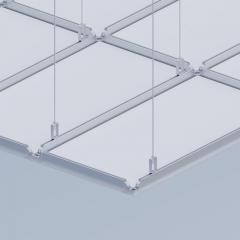
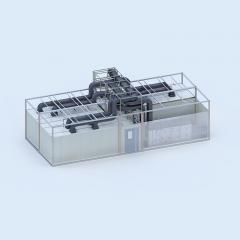
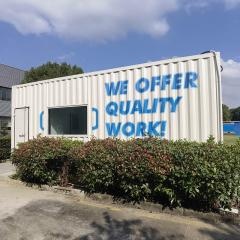
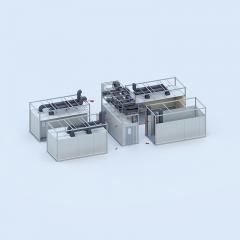
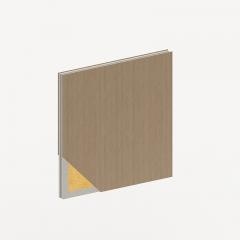
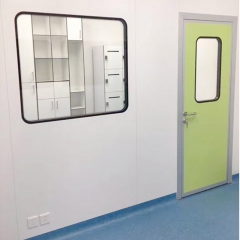
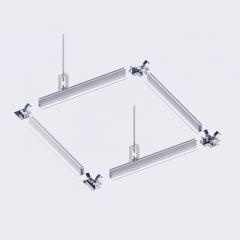
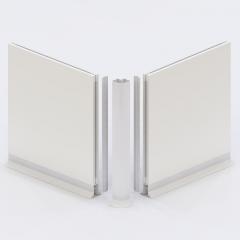
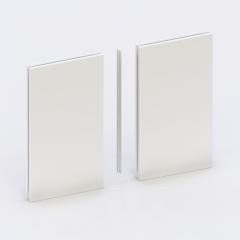
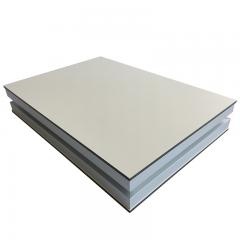
The cleanroom ceiling system plays a critical role in maintaining cleanliness, controlling airflow, and integrating various utilities within a cleanroom environment. The structure of a cleanroom ceiling system typically consists of several key components, which I'll outline below: Ceiling Grid: The ceiling grid forms the primary structural support for the cleanroom ceiling system. It is usually made of aluminum or steel and comprises a network of interconnected beams and crossbars. The grid provides stability and allows for the integration of other ceiling components. Ceiling Panels: Cleanroom ceiling panels, also known as ceiling tiles or plenums, are suspended from the ceiling grid and form the visible surface of the cleanroom ceiling. These panels are designed to have smooth, cleanable surfaces to minimize particle generation. They are often made of materials such as aluminum, steel, or fiberglass-reinforced plastic (FRP). Gasketed Seals and Joints: To ensure an airtight and particle-free cleanroom environment, gasketed seals and joints are used in cleanroom ceiling systems. These seals help minimize air leaks and prevent contamination from entering the cleanroom through gaps or openings. Lighting Fixtures: Cleanroom ceiling systems incorporate lighting fixtures that meet the specific lighting requirements of the cleanroom environment. These fixtures are typically recessed into the ceiling panels to maintain a smooth and clean surface. Cleanroom lighting options can include LED lights, which provide energy efficiency and generate minimal heat. Filters and HEPA/ULPA Units: Cleanroom ceiling systems often incorporate filters and High-Efficiency Particulate Air (HEPA)/Ultra-Low Penetration Air (ULPA) units to provide clean, filtered air to the controlled environment. These units are integrated into the cleanroom ceiling, ensuring that the supplied air is free from particles and contaminants. Utilities Integration: Cleanroom ceiling systems may include utility services integration, such as ductwork for HVAC (Heating, Ventilation, and Air Conditioning) systems, piping for clean gases, or electrical conduits for power distribution. These utilities are often concealed within the ceiling system to optimize space and maintain a clean appearance. Access Points and Hatches: Cleanroom ceiling systems may have access points and hatches for maintenance and equipment installation purposes. These access points allow for easy entry into the plenum space above the cleanroom ceiling, enabling maintenance personnel to access utilities or perform equipment adjustments without compromising cleanliness. It's important to note that cleanroom ceiling systems can vary depending on the specific requirements of the cleanroom, such as cleanliness class, airflow patterns, and ceiling height. Cleanroom design professionals and cleanroom construction companies utilize industry standards and guidelines to ensure the ceiling system is designed and installed correctly to mainta...
Cleanroom wall systems have specific material requirements to ensure the integrity and cleanliness of the controlled environment. The selection of materials for cleanroom walls depends on factors such as cleanliness class, chemical resistance, durability, ease of cleaning, static control, and fire safety. Here are some common material requirements for cleanroom wall systems: Smooth and Nonporous Surfaces: Cleanroom walls should have smooth, nonporous surfaces to prevent the accumulation of particles and facilitate easy cleaning. Materials such as painted steel, stainless steel, fiberglass-reinforced plastic (FRP), or rigid vinyl are commonly used due to their smooth surface properties. Chemical Resistance:Cleanroom wall materials should be resistant to chemicals and cleaning agents used in cleanroom environments. This resistance ensures that the walls can withstand regular cleaning and disinfection without degradation or particle generation. Resilient materials like FRP or coated steel are often chosen for their chemical-resistant properties. Non-shedding and Low Particle Generation: The selected wall materials should be non-shedding and have minimal particle generation. This reduces the risk of contaminating the cleanroom environment. Smooth and homogeneous materials without seams or joints, such as stainless steel, painted steel, or solid surface panels, are preferred to minimize particle generation. Static Control: Depending on the application, cleanroom walls may need to have static control properties to mitigate the buildup of electrostatic charge. Antistatic or static-dissipative materials, such as conductive vinyl, conductive laminates, or electrostatic dissipative (ESD) coatings, may be used to prevent damage to sensitive equipment or products. Cleanroom Compatibility: The selected materials should be compatible with the overall cleanroom design and construction requirements. They should integrate well with other cleanroom components, such as doors, windows, ceiling systems, and HVAC systems. Compatibility ensures a seamless and effective cleanroom construction process. Fire Safety: Cleanroom walls should meet fire safety regulations and have appropriate fire resistance ratings. Fire-rated materials, such as fire-resistant drywall, steel with fire-resistant coatings, or composite panels with fire-resistant cores, may be used to enhance the fire safety of the cleanroom facility. Durability and Maintenance: Cleanroom walls should be durable to withstand the rigors of cleanroom operations and maintenance activities. The selected materials should be resistant to scratching, impact, and wear. They should also be easy to clean and disinfect without compromising their structural integrity. It is important to note that the specific material requirements for cleanroom wall systems may vary depending on the desired cleanliness class and industry-specific standards. Consulting with cleanroom experts, architects, or specialized cleanroom construction...
Cleanroom doors are an essential component of cleanroom facilities, as they help maintain the integrity of controlled environments by preventing the ingress of contaminants. Several types of cleanroom doors are commonly used, each with its specific features and suitability for different cleanroom applications. Here are some common types of cleanroom doors: Swing Doors: Swing doors are the most basic and commonly used type of cleanroom doors. They operate on hinges and open and close like traditional doors. Swing doors can be single-leaf or double-leaf, depending on the width of the doorway and the required access space. They are usually made of smooth, non-shedding materials to prevent particle generation and are commonly used in cleanrooms with lower cleanliness requirements. Sliding Doors: Sliding doors are designed to move horizontally along a track system. They are often used in cleanrooms where space is limited or when swing doors are not suitable due to traffic flow or air pressure differentials. Sliding doors offer smooth and easy operation while minimizing the potential for air turbulence and particle generation during usage. Roll-Up Doors: Roll-up doors, also known as high-speed doors, consist of slats or fabric that roll up into a compact housing above the door opening. These doors are typically made of durable materials that can withstand frequent opening and closing. Roll-up doors are commonly used in high-traffic areas or where fast access is required, such as in pharmaceutical or manufacturing cleanroom environments. Strip Doors: Strip doors, also referred to as strip curtains or PVC strip doors, are flexible door systems consisting of overlapping plastic strips that hang from a header track. These strips allow for easy passage while minimizing the exchange of air and contaminants between different areas. Strip doors are useful in cleanrooms where frequent access is necessary, but maintaining a controlled environment is still important, such as in laboratories or storage rooms. Air Lock Doors: Air lock doors, also known as interlocking or double-door systems, are designed to create an intermediate space between two cleanroom areas to prevent cross-contamination. They consist of two doors, usually with an automated control system that ensures only one door can be open at a time. When one door is open, the other remains closed, preventing the transfer of contaminants between the areas. Pass-Through Doors: Pass-through doors, or cleanroom transfer hatches, are small doors or chambers built into cleanroom walls to facilitate the transfer of materials or equipment without compromising the cleanliness of the controlled environment. They are designed to allow for the transfer of objects or samples between cleanroom and non-cleanroom areas while maintaining the required cleanliness standards. These are some of the common types of cleanroom doors used in various cleanroom applications. The choice of door type depends on factors such as clean...
The development prospects of modular laboratories are promising and continue to grow rapidly. Here are some key factors that contribute to their positive outlook: Increasing Demand for Research Facilities: The need for research and testing facilities in various industries, including healthcare, pharmaceuticals, biotechnology, and materials sciences, is consistently growing. Modular laboratories provide a flexible and efficient solution to meet these evolving demands. Their adaptable nature allows for customization and quick deployment, enabling organizations to establish research facilities in a timely manner. Technological Advancements: Advancements in modular construction techniques, materials, and technologies have greatly enhanced the capabilities of modular laboratories. Modern modular designs offer highly specialized and fully functional spaces that can accommodate advanced equipment, meet stringent environmental control requirements, and ensure safety and regulatory compliance. Expansion of Research and Development Activities: Research and development activities continue to be vital for innovation and competitiveness across industries. Modular laboratories provide organizations with the flexibility to scale up or down their research operations based on changing project needs, budgets, or market dynamics. The ability to quickly adapt to changing research priorities and requirements positions modular laboratories as a valuable asset for R&D purposes. Cost and Time Efficiency: Modular laboratories offer significant cost and time advantages over traditional construction methods. The off-site fabrication process reduces on-site construction time, minimizes disruptions, and lowers labor costs. Moreover, the streamlined production process and standardized assembly techniques result in cost savings and predictability of project timelines. Sustainability Considerations: The focus on sustainability and energy efficiency is driving the demand for eco-friendly laboratory solutions. Modern modular laboratory designs often incorporate sustainable building materials, energy-efficient systems, and waste management strategies. These features align with the global push toward environmental stewardship and sustainable practices. Mobile and Temporary Research Needs: The ability to quickly establish mobile or temporary research facilities is essential in various situations, such as field research, clinical trials, disaster response, or remote exploration. Modular laboratories can be rapidly deployed, making them well-suited for such scenarios. They enable researchers to have access to fully functional laboratories in challenging or time-sensitive environments. Collaboration and Interdisciplinary Research: Collaboration and cross-disciplinary research are becoming increasingly important for addressing complex challenges. Modular laboratory designs can incorporate flexible and shared spaces that promote collaboration among researchers from different fields o...
Clean rooms have had a significant impact on modernity across various industries and fields, particularly in the areas of technology, healthcare, and scientific research. Clean rooms are controlled environments designed to minimize contamination from airborne particles, dust, microbes, and other contaminants. They typically feature advanced air filtration and purification systems, strict protocols for entry and cleanliness, and specialized equipment and apparel for employees. Here are some ways clean rooms have influenced modernity: 1. Semiconductor and Electronics Industry: Clean rooms are essential in the manufacturing of semiconductors, microchips, and electronic devices. These facilities ensure that the production environment is free from contaminants that could adversely affect the performance and reliability of sensitive electronic components. The cleanliness and precision in these environments have contributed to the development of smaller, faster, and more powerful technologies, driving advancements in computing, telecommunications, consumer electronics, and automation. 2. Healthcare and Pharmaceuticals: Clean rooms play a crucial role in pharmaceutical manufacturing, research and development, and sterile healthcare environments. They are used for the production of sterile drugs, vaccines, and medical devices, ensuring the safety and efficacy of these products. Clean rooms also provide controlled environments for surgeries, isolation units, and bio-containment facilities, protecting patients and medical staff from infections and contaminants. 3. Biotechnology and Life Sciences: Clean rooms are extensively employed in biotechnology and life sciences research. They are used for the cultivation of cell cultures, production of recombinant proteins, genetic engineering, tissue engineering, and pharmaceutical research. Clean rooms provide the necessary conditions to isolate and manipulate biological samples without contamination, allowing scientists to conduct precise experiments and develop innovative therapies. 4. Aerospace and Precision Engineering: Clean rooms are utilized in aerospace manufacturing and precision engineering industries, where the assembly of sensitive components requires strict environmental control. They are used in the production of aircraft, satellites, spacecraft, and high-precision instruments. Clean rooms enable the assembly and testing of these complex systems in contamination-free environments, ensuring their reliability and safety. 5. Environmental and Material Sciences: Clean rooms are instrumental in the study of materials and the characterization of nanoscale structures. They provide controlled conditions for nanotechnology research, materials testing, and surface analysis. Clean rooms also contribute to environmental monitoring by offering particle-free environments for the calibration of sensitive instruments and the analysis of air, water, and soil samples. Overall, clean rooms have revolutionized modernity b...
In the process of clean room decoration, the selection of materials is an important process, which is divided into the selection of pipe materials, the selection of color steel purification materials and the selection of clean floor materials. 1. Selection of air duct materials The new GMP classifies cleanliness classes using the new WHO and EU classification standards A, B, C and D. The cleanliness of the clean room is generally Class C, local Class A or Class B. It is required that the air ducts of the clean air-conditioning system should be made of galvanized steel with good quality and performance. The galvanized steel sheet should have a uniform galvanized layer without obvious oxide layer, and the galvanized layer should be free of pinholes, pitting, scaling, blistering and falling off. Coat hangers, connecting bolts and rivets should be galvanized. The air duct flange can be processed with ordinary angle steel, but the rust removal and anti-rust paint work should be done well. The external insulation of the air duct generally adopts rubber and plastic insulation, and the air duct of the smoke prevention and exhaust system adopts glass wool insulation. 2. Selection of materials for cleanroom sandwich panel purification In order to meet the requirements that the clean room is not easy to accumulate, the enclosure structure of the clean workshop adopts non-combustible purification color steel plate. Purification wall panels should be corrosion-resistant, dust-proof, smooth, high-strength, and have a good sealing effect. Generally, 50 (76) and 100 metal wall panels are used. The panel material is polyester color steel plate, the inside is gypsum board, and the outside is moisture-proof galvanized steel plate. Purification ceiling requires good toughness, good smoothness and high strength. Generally, 55 type magnesium lined paper honeycomb purification color steel plate ceiling is used. The ceiling is made of polyester coated color steel sheet, 5 mm thick magnesium board, paper honeycomb panel and 5 mm thick magnesium board, glued together. Through this reinforcement structure and reliable hoisting, the walking load of maintenance personnel can be satisfied. Food grade sealant is used to seal the gap between the cleaned color steel plates to reduce the dust accumulation area. 3. Selection of clean floor materials The clean floor of the clean room is usually composed of epoxy mortar self-flowing platform and PVC floor. Ordinary epoxy self-flowing platform is mainly composed of mortar and surface coating. The epoxy mortar system consists of epoxy resin, amine curing agent and graded aggregate mixed with inorganic pigments. According to the construction requirements, the construction thickness of the system is 36 mm. Welcome to inquiry for clean room sliding doors、aluminium ceilings and modular partition wall systems etc.